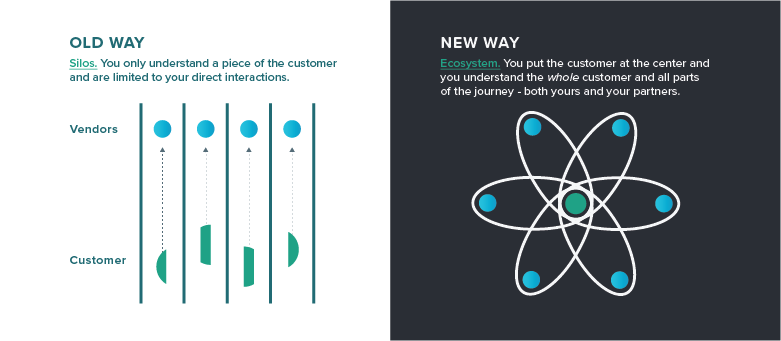The way most businesses address the customer experience is broken – literally. It’s broken up into separate silos that create friction and fragment the customer journey.
Fortunately, the technology exists to put the pieces back together.
Companies that embrace collaborative, omnichannel support tools and practices within their organization are already on the right track. However, they still struggle to provide seamless support when third-party service providers are involved – which is almost always the case, especially for tech companies.
So, if we know that it takes multiple service providers and vendors to keep customer devices online and functional, why don’t these companies work together to improve the entire customer experience?
Sharing knowledge and customer information with other providers in your non-linear digital supply chain – or business ecosystem – can provide the competitive edge necessary to succeed in an increasingly-interconnected world.
Today, we’re looking ahead to how technology companies can come together to repair the customer experience once and for all. More specifically, we’re discussing how building a business ecosystem can tear down the information silos controlled by different organizations – and reimagine the customer journey entirely.
Technology is Dissolving Industry Boundaries and Redefining the Customer Journey

Traditionally, customer relationships and interactions were perceived on a one-to-one basis: one customer interacting with one business to get the support or service they need.
However, technology and businesses are now so intertwined that the customer experience has changed. We’ve shifted to an interconnected digital marketplace, where industry boundaries are blurred and businesses depend on each other to deliver their products and services to the end-user.
As a result, the modern customer experience is based on a one-to-many dynamic. That is, one customer interacting with multiple service providers at various points of their journey.
The Problem: The Customer Journey Is Fragmented
Nobody wins with silos in place, because a lack of shared knowledge between interconnected service providers is frustrating for all parties. If a customer has a service issue with any of the providers in your ecosystem, they might not even know who to contact for support.
One possibility is that they’ll call your team and find that you’re unable to help them resolve the issue, because it’s not related directly to your technology. Or maybe they’ll have already contacted a few different companies before getting in touch with your team.
Either way, the customer has experienced a service failure.
Not only does this create unnecessary friction for an already-frustrated customer, but it hampers your ability to provide fantastic, seamless support. This reflects poorly on your brand’s reputation and that of other players in your ecosystem.
The Solution: Build and Participate in Business Ecosystems

As tech companies become more interconnected and dependent on multiple service providers, the customer experience hinges more sharply on how well your product or service works with related services and devices. In order to stay competitive, companies need to open up new lines of communication with other businesses serving the same customers.
That’s where building and participating in a business ecosystem comes in. Thanks to existing support technology and tools, multiple businesses can work together to serve customers collaboratively.
By sharing customer information, knowledge, and context across organizations, companies within a business ecosystem are able to provide a truly seamless customer experience at every touchpoint.
The Benefits of an Interconnected Business Ecosystem

1. Streamlined Customer Journeys
Support is no longer a conversation between you and the customer – it’s a relationship between all the businesses in your ecosystem and the customer. Working with other players in your business ecosystem allows you to zoom out and perceive the entire customer journey holistically.
2. Direct Access to Universal Knowledge
An interconnected business ecosystem allows you to access the knowledge you need when you need it. This is true whether the information exists within your own knowledge base or belongs to another business in your ecosystem. By participating in a business ecosystem, you can empower your own agents to provide a more seamless customer experience.
3. Faster Customer Service at Every Touchpoint
No one wants to call three different service providers to get a straight answer to one question. When you share knowledge and customer data with other providers in the business ecosystem, you’re elevating the customer experience at every touchpoint. This enables your ecosystem partners to provide faster, seamless support and service, regardless of which business the customer contacts for help.
4. More Opportunities to Strengthen Customer Loyalty
Collaborating with the diverse players in your business ecosystem is mutually-beneficial. Ecosystem participants work together to prevent customer churn, inspire long-term loyalty, and, ultimately, strengthen their position as leaders in customer experience and support.
The Shift Towards Business Ecosystems is Already Underway: Are You Ready to Respond?
The shift towards business ecosystems is already happening. A survey by Accenture found that 81% of business and technology executives believe boundaries will blur between industries as technology empowers companies to work together within interconnected business ecosystems.
What does this mean for your business? How can your support team prepare for or help build stronger ecosystems? Let’s take a look at what it takes to build a thriving business ecosystem.
A New Understanding of End-to-End Customer Experiences
Traditionally, support teams focus on the relationship between the customer and their business. They aren’t necessarily concerned with the service provided by some other company that sells a related product. However, it no longer makes sense to think of the customer journey as a one-to-one experience, because every product and service relies on third-party services and technology. Delivering optimal customer experiences in the new customer environment requires cooperating as part of a larger system and partnering with other providers who serve your customers.
A Culture Shift Within the Organization
Large-scale change starts from within. In addition to adopting omnichannel and collaborative support practices internally, a thriving ecosystem requires a willingness to share knowledge and insights with partnering organizations. Working with other service providers and vendors allows every member of the ecosystem to provide better customer experiences overall.
Adoption of Collaborative Support Technology
Once you understand the whole customer journey and context, you need access to the right knowledge to answer their questions. Your organization needs to implement technology that enables collaboration across all departments and teams, including third-party service providers within your business ecosystem. By sharing knowledge across organizations, your support team is able to deliver amazing service to every customer – even if the issue isn’t related directly to you or your products.
Technology is Reshaping the Customer Journey and Establishing Business Ecosystems
As the customer environment become increasingly interconnected, companies need to recognize the value of business ecosystems. After all, your customers aren’t just your customers – they’re served and supported by a number of companies that provide complementary services or products.
Collaborative support technology makes it easier for businesses to share knowledge and context across different teams and organizations. By partnering with other providers who serve your customers, you can build a powerful business ecosystem that supports your shared goals of minimizing friction and delivering consistently amazing customer experiences.





